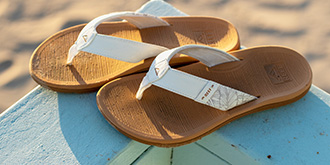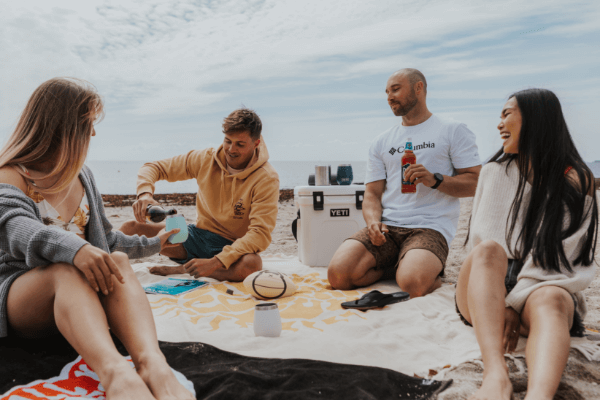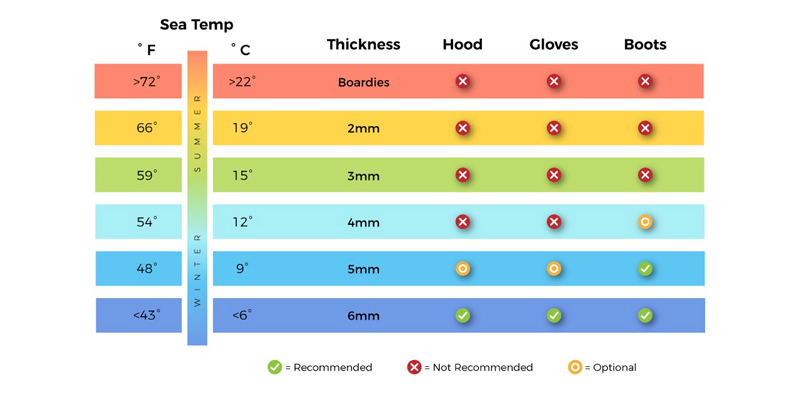>> Choosing your first Wetsuit.
>> How should my Wetsuit fit?
>> Is my Wetsuit too tight?
>> What Wetsuit size am I?
>> What Wetsuit size is my child?
>> Trying on your first Wetsuit.
>> What do I wear under my Wetsuit?
>> How to put on a Back Zip Wetsuit.
>> How do I put on a Chest Zip Wetsuit?
>> How to take a Wetsuit off properly.
>> How to look after your Wetsuit.
>> How do Wetsuits work?
>> Wetsuits VS Supermarket Wetsuits.
>> Wetsuit Jargon Buster.
>> Wetsuit Warranty.
Buying a Wetsuit - The Ultimate Wetsuit Guide.
Ann’s Cottage have Europe’s biggest range of Wetsuits and Wetsuit Accessories. We stock O’Neill, Quiksilver, Roxy, Gul, C-Skins, Vissla, Animal, Alder and Billabong Wetsuits. Rest assured we have you covered.Choosing your first Wetsuit.
How long do you want to spend in the water? What is your tolerance of the cold water? What time of year do you surf? How many times a year do you surf? Answer these questions and you should be on your way to picking out the correct Wetsuit. It sounds obvious but the more you pay for a wetsuit the warmer and more flexible they become. If you feel the cold more than most, think about investing in a slightly more expensive Wetsuit (£100-£200) or if you only surf once a year in the summer, an entry level wetsuit (£30-£70) would be absolutely fine. The sea temperature changes quite considerably throughout the year. In the Atlantic on a cold winters day the ocean can get down to around 6 Degrees Centigrade and on a warm summers day it can reach up to 18 Degrees Centigrade. A general rule of thumb is that a good Blindstitched 3/2mm Wetsuit will be suitable from May to December and a 5/3mm Wetsuit will see you through most winters. Shorty Wetsuits work well in the height of summer (July/August) or if you’re just chilling or playing on the beach. Use our helpful guide to see what thickness Wetsuit is best for you. One other thing to take into consideration is the zip placement. Chest zip Wetsuits are becoming more and more popular because they don’t have the back zip restricting the Wetsuits' flexibility. They are comfortable to wear and reduce the flushing of water through your Wetsuit. A good back zip Wetsuit can more than equal the popular chest zip and really it's down to preference. It's worth noting that back zips are slightly easier to get into if you have limited movement.
How should my Wetsuit fit?
The correct fitting Wetsuit is absolutely essential to your enjoyment and happiness in the water. Too loose and water will flush through the Wetsuit, too tight and you will look and feel like a Raspberry. Every Wetsuit brand has a different shape, so you might find that the cut of an O’Neill Wetsuit fits you better than the cut of a Billabong Wetsuit. Essentially when you’re in the Wetsuit you are looking for a nice all round snug fit.
Is my Wetsuit too tight?
If it looks like you’re cutting off the blood circulation to your hands and feet it’s too tight. If you can grab a bundle of neoprene anywhere on the Wetsuit, it’s too loose. The Wetsuit should sit flush with the small of your back, this is a good way of knowing if it fits around your core. The neck seal takes a bit of getting used to at first, It’s meant to be reasonably tight to reduce water flushing through the Wetsuit. A brand new Wetsuit does give a little and feel more comfortable after a couple of uses.
What Wetsuit size am I?
We have an individual Wetsuit size guide for every single brand and model. If in between sizes try going up and if you have any questions please don’t hesitate to call one of our experts. The Wetsuit size guides. can be found on the link below.
What Wetsuit size is my child?
We know Kids grow up fast so it is important to strike a balance between geting a good fitting wetsuit that will also last as long as possible. Luckily most kids wetsuit sizes are listed by age, which gives a good starting point and a rough guide but the size charts found on each product page are definitely worth checking. The most important measurements to get right are the body (chest and waist) measurements, as it is these that will determine how well the wetsuit will fit a childs body/torso, which is vital for the wetsuit to work effectively and keep your child warm. It’s not a complete disaster if the wetsuit is too long on the body but it is important that the wetsuit fits around the core, otherwise the wetsuit just won’t do its job.
Trying on your first Wetsuit.
If you’re heading to one of our stores be prepared to try a few on. It can be hard work but the rewards are worth it. When you come to buy another suit in the future people generally stick to the same brand and size. If you really struggle getting in and out you can always put plastic bags on your feet to help your legs slide into the Wetsuit. Lubricants like Vaseline can be harmful to the Wetsuit so we recommend against using it. Putting on a Wetsuit will get easier over time, we promise.
What do I wear under my Wetsuit?
This is completely up to you. A lot of people choose to go in their birthday suit but any swimwear will suffice. For Wetsuits that have a thermal lining inside try to avoid wearing a Rash Vest as it inhibits the performance of the Wetsuit.
How to put on a Back Zip Wetsuit.
1) Take off any sharp objects, rings, watches etc.
2) The zip goes at the back of the Wetsuit. Prepare the Wetsuit by folding the top half of the Wetsuit down revealing the two leg holes.
3) Pointing your toes to the floor pull your Wetsuit over your foot and ankle, gradually working it up over the knee one leg at a time. Once the Wetsuit is at thigh level repeat the process with the other leg.
4) You can now pull the Wetsuit up to your waist. Use the sides of the Wetsuit to pull the Wetsuit up avoiding tugging on the front and back panels. The single line neoprene on these panels can be vulnerable to sharp finger nails. Take time to straighten out any creases by gently working the Wetsuit up the legs. Centre the Wetsuit knee pads with your own knees.
5) Slowly work the Wetsuit up your torso and insert one arm in at a time. Once your first arm is in, straighten out any creases pulling the Wetsuit up over your shoulder. Repeat the process for your second arm. At this stage your Wetsuit should fit nice and snugly and no neoprene should be bunched up anywhere on the suit.
6) Find the long string attached to the zip. Holding the bottom of the zip with one hand pull the string up with the other hand. Once the zip is up round your neck seal the deal by using the Velcro neck fastener at the top of your Wetsuit (you can always get a buddy to help you with this).
How do I put on a Chest Zip Wetsuit?
1) Take off any sharp objects, rings, watches etc.
2) The zip goes at the front of the Wetsuit. Prepare the Wetsuit by folding down the top half of the Wetsuit down revealing the two leg holes.
3) Pointing your toes to the floor pull your Wetsuit over your foot and ankle, gradually working it up over the knee one leg at a time. Once the Wetsuit is at thigh level repeat the process with the other leg.
4) You can now pull the Wetsuit up to your waist. Use the sides of the Wetsuit to pull the Wetsuit up avoiding tugging on the front and back panels. The single line neoprene on these panels can be vulnerable to sharp finger nails. Take time to straighten out any creases by gently working the Wetsuit up the legs. Centre the Wetsuit knee pads with your own knees.
5) Slowly work the Wetsuit up your torso and insert one arm in at a time. On a chest zip Wetsuit it’s sometimes easier to put the left arm in first bringing any access neoprene to the shoulder. Repeat the process for your second arm.
6) At this stage your Wetsuit should fit nice and snug without any neoprene bunched up anywhere on the suit. Straighten out any folds on the neck and bring the neck panel (which is currently hanging free at the back of your Wetsuit) over your head. Zip the panel up.
How to take a Wetsuit off properly.
It important for the longevity of your Wetsuit that you take it off correctly. Peel the Wetsuit off gently so you should find the Wetsuit inside out when it’s completely off. Remember that the single line neoprene on the front and back panels can be vulnerable to sharp objects so always pull on the sides of the Wetsuit. Try to avoid standing on your Wetsuit to pull your feet out. Use a Wetsuit matt or changing bucket to stop the Wetsuit getting snagged on any rocks and it helps to keep your Wetsuit clean.
How to look after your Wetsuit.
Wetsuits don’t last for ever but looking after your wetsuit properly will have a dramatic effect on its' life expectancy.
1) Wash out your Wetsuit in cold water after every use.
2) Don’t dry it out in direct sunlight.
3) If you’re not using it for a while don’t leave it on a hanger but roll it up and store it somewhere dry.
4) If it smells like wee use a proper Wetsuit cleaner (URL). Don’t use household chemicals and definitely don’t put it in the washing machine.
How do Wetsuits work?
Wetsuits are amazing things, with today’s technology we can stay warm in the coldest of conditions. We now have more freedom than ever, our movement is no longer restricted like the old wetsuits of yesteryear.
Your Wetsuit is made up of panels of Neoprene. This rubbery compound insulates you from the cold water outside. Wetsuits are not designed to keep you entirely dry. A small amount of water gets trapped between your body and the neoprene. Your body temperature then heats up this small amount of water giving you a nice warm feeling. This is why finding the correct fitting Wetsuit is absolutely essential. Heat does eventually escape through the neoprene but very much like clothing the thicker the Neoprene the warmer you will be.
Wetsuits VS Supermarket Wetsuits.
“There are lots of cheap wetsuits in supermarkets these days, but if your children are getting into their watersports, you may want to dig a little deeper. In all cases, try before you buy.” – RNLI Magazine
We advise against buying a cheap Wetsuit from a supermarket. A Wetsuit is a technical piece of swimwear which keeps you warm during long days on the beach or in the ocean. You lose the quality and durability when buying Supermarket wetsuits and they aren’t up to scratch.Wetsuit Jargon Buster.
Flat Lock Stitch. The Flat Lock Stitch can be found on most entry level wetsuits and shorties. It’s great for the summer and offers a durable solution for Kid’s wetsuits. The seams of the Wetsuit are placed together and the stitch passes all the way through the neoprene hence it’s not as watertight as the mighty Blind Stitch.
Blind Stitch. The Blind Stitch can be found on most mid range to high end Wetsuits and almost all winter Wetsuits. It is known as a more watertight stitch than its' Flat Lock cousin. The seams of the Wetsuit are glued together and the stitch is inserted only half way through the neoprene, meaning there are less holes for water to get in.
Liquid Seams. Liquid Seams are essentially a small rubber seal that covers the edge of the neoprene panel where the stitch lays. Some manufactures use the Liquid seal on the inside the Wetsuit and some on the outside covering the Blind Stitch and offering greater durability. They also use it on both the inside and outside eliminating the need for a stitch at all.
Thermal Lining. Thermal Lining or Firewall can be found on the inside of your Wetsuit. It is looks like a fluffy lining and has multiple uses. As well as it being fluffy and comfortable on the skin it reduces the amount of water that sits around your core which helps keep your whole body warm. Wetsuits with this lining also dry quicker which is great for surfing in the winter time.
Batwing. The Batwing can be found on back zip wetsuits only. It is built into the Wetsuit to act as an extra barrier between the zip and your body and reduce flushing. On the majority of Batwing Wetsuits you pull it over your head before you zip up the suit.
Convertible Wetsuits. On a convertible Wetsuit the arms and or legs are detachable. Velcro is normally used to make the attachment.
Single Line Neoprene. This relates to the shiny rubbery panel on the front and or back of the Wetsuit. Single line is great for deflecting wind and is normally found around the middle of the Wetsuit keeping your core warm. It can be vulnerable when faced with a sharp object.
Flushing. Flush happens when water passes all the way through the Wetsuit replacing the small amount of water you have been warming up. Flushing happens with any Wetsuit but is considerably reduced by buying a Wetsuit with a Batwing or a quality Chest Zip.
Steamers. Steamers is just another way of saying Wetsuit. It was coined by the pioneers of the Wetsuit industry relating to the steam that’s given off when someone takes their Wetsuit off on a cold day.
Wetsuit Warranty.
We thoroughly check over all Wetsuits before they are sent out. Be careful with sharp finger nails on the single line neoprene, it's easily repairable but it's not covered by warranty. Wetsuit warranties cover most legitimate faults but they do not cover normal everyday wear and tear. A Wetsuit doesn't last forever but you can extend it's life by looking after it properly. Keep hold of your original receipts and ideally the Wetsuits tags to validate the warranty.

























































 Tracked Delivery on all orders
Tracked Delivery on all orders EASY Returns
EASY Returns
